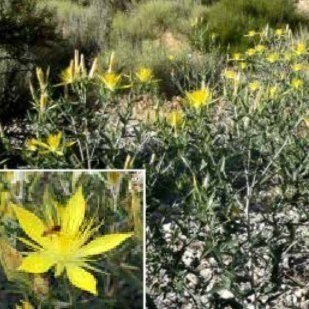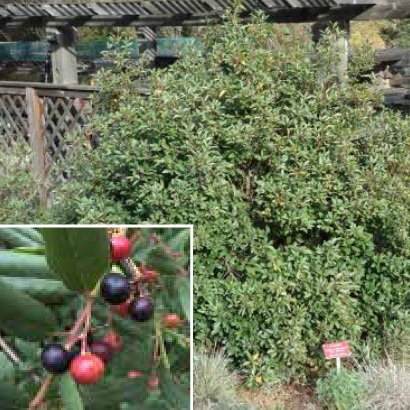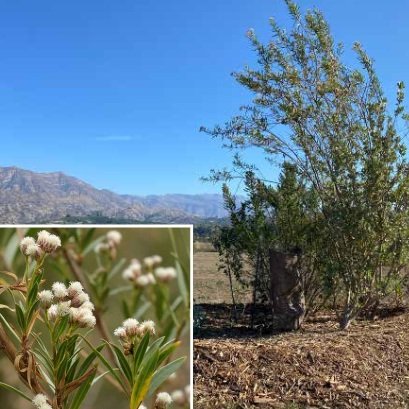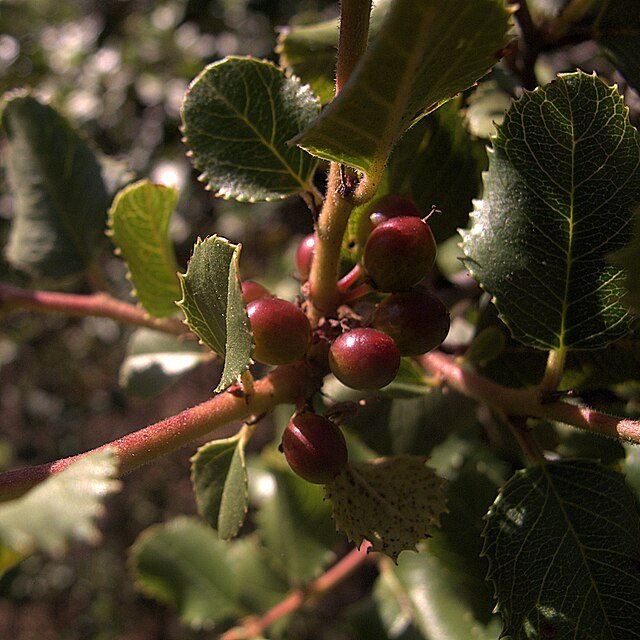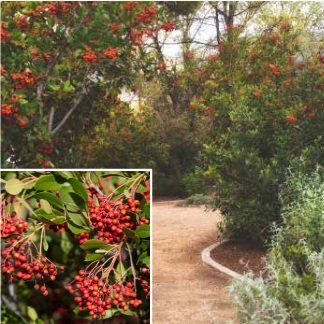
PLANT Guide
OVLC GROWN NATIVE PLANTS
Native plants provide food and shelter for local wildlife, like birds and insects. By planting a native plant, you can help support the local ecosystem and preserve the unique biodiversity of your region. This guide contains OVLC grown native plants. Download a PDF of this guide or view the plants below.
-
(Arctostaphylos glauca)
Big berry manzanita is a beautiful woody shrub with shimmering leaves and twisting auburn branches. The personality of this plant is a staple of California ecology, as it provides invaluable habitat and food for all organisms. These plants were propagated from local individuals within the floodplain of the Ventura River. Give these a home to support their dwindling population.
-
(Salvia mellifera)
Black sage is a medium-sized shrub that thrives in gardens with full sun to partial shade. Although it’s adapted to be drought-deciduous, with a little year-round watering, it can maintain its verdant appearance throughout the year. This makes it an excellent choice for beginners, as it requires minimal care and can survive over or underwatering. Additionally, black sage can be pruned to maintain a more compact shape and prevent legginess.
-
(Mentzelia laevicaulis)
Blazing star is a desirable species for rock gardens and dry areas. They are a source of nectar and pollen for native bees, butterflies, and moths. One unique feature of this species is the flowers open at dusk and remain open overnight and into early morning before closing by the afternoon. If you’re looking to add something with a vibrant flair to your yard and some night time fun, then blazing star is the right choice for you!
-
(Sisyrinchium bellum)
Sisyrinchium bellum, the California blue-eyed grass, is an excellent choice for your native plant garden due to its adaptability to a wide range of soil types and its ability to thrive in both full sun and partial shade. This native gem not only offers a striking display of delicate, sky-blue flowers but also serves as a reliable nectar source for local pollinators, making it a valuable addition to your garden’s ecosystem. Its compact size and minimal maintenance requirements make it a practical and visually appealing choice for a sustainable and wildlife-friendly landscape.
-
(Encelia californica)
The bush sunflower is a classic coastal sage scrub shrub that produces vibrant sunflowers in early spring. One shrub can have dozens of rich flowers and is deciduous in the summer. This is an excellent choice for beginners as it’s easy to care for. For year-round verdancy, consider pairing it with a sage or other plant that remains green in the summer.
-
(Brickellia californica)
The California brickellbush is a fragrant shrub that can thrive in the hot summers of Ojai. Although it’s not particularly showy, this plant adds texture and personality to your garden and attracts pollinators. It’s also well-suited to high, exposed, hot areas.
-
(Juglans californica)
The California black walnut is a locally threatened tree that can provide height and shade to your garden. It’s naturally found on hillsides, valleys, and canyons near stream beds and washes. Historically, they were scattered all around the Ojai Valley. This tree is an essential food source for wildlife and plays an important role in the ecosystem.
-
(Elymus glaucus)
Blue rye is a charming native bunch grass that’s ideal for adding texture to multiple layers of your garden when planted between shrubs and other plantings. The erect tufts of grass blades have a blue hue and are accompanied by a fibrous root system that retains water and helps prevent weed growth.
-
(Vitis Californica)
California grape is perfect for fences and covering structures. It’s great to use as a windbreak, but if it has nowhere to climb, it also provides fantastic ground cover. The flowers of this vine-like native are loved by bees, and it’s one of the best plants for butterflies in the fall.
-
(Eriogonum fasciculatum)
California buckwheat is a classic plant in the Ojai Valley. This resilient shrub produces showy white flowers that turn rusty auburn in the fall. Buckwheat grows well in full sun and is an excellent choice if you want late summer blooms to attract pollinators. Additionally, it can be trimmed back in late fall or early winter to maintain a compact form.
-
(Ranunculus californicus)
The California buttercup is a perennial herb with charming yellow flowers. It can serve as a low ground cover. The California buttercup goes dormant in summer, but it is easy to propagate. It prefers high levels of moisture.
-
(Epilobium canum)
The California fuchsia is an easy-to-grow, sprawling perennial that produces showy blooms in late summer. Its deep red flowers are particularly attractive to hummingbirds, while its speared gray leaves add layers of color to your garden.
-
(Rosa californica)
The California wildrose is a spreading, thicket-forming shrub that is deciduous in the winter. It produces delicate pink flowers and delicious red rose hips, making it a great addition to wild, moist areas in your garden. Note that this plant will spread via rhizomes if not contained.
-
(Delphinium cardinale)
The cardinal larkspur is a grand and showy perennial wildflower that is endemic to Southern California chaparral. This plant can grow up to 6 feet tall and produces stunning red flowers. It will thrive in hot, exposed areas with no summer water.
-
(Ribes malvaceum)
The Chaparral currant is a perennial shrub. It has bright pink flowers and purple edible berries. The Chaparral currant supports native birds and pollinators. It tolerates low moisture and part to full sun.
-
(Artemisia californica)
California sagebrush is a favorite among California native shrubs due to its ability to thrive in a variety of gardens. It does well in both full sun and partial shade. Its fragrance is a quintessential California scent, while its wispy blue leaves, which are adaptedtodroughtconditions,lookbeautifuleven in the height of summer.
-
(Quercus agrifolia)
These coast live oak seedlings are from locally sourced acorns, which makes them particularly special. When you plant this oak tree, it becomes a staple in our ecosystem, supporting 600+species in our local community. If you are looking for a large tree to plant so future generations can enjoy shade and a healthy ecosystem, we recommend planting this seedling in a clear and open space. Water deeply once a month during dry months for three years to establish.
-
(Frangula californica)
Coffeeberry is an evergreen shrub that can grow tall with dark red branches and oval-shaped green leaves. It is commonly found all over California and is a great choice for providing height and shade to a part-shade garden.
Coffeeberry also produces small, purple-black berries in the fall that are a great food source for birds and other wildlife.
-
(Lonicera subspicata)
The chaparral honeysuckle is a large, mounding, and spreading shrub that grows well in any area of your garden. Its sweet nectar attracts many pollinators with its beautiful yellow flowers. With propertraining,thisshrubcanalsobeencouraged to climb fences or trees and can be transformed into a beautiful vine.
-
(Malacothamnus nuttallii)
The chaparral mallow is a tall and spreading shrub that thrives in wild, exposed areas of your garden. Its soft, hand-shaped leaves have a classic green hue that evokes the Ojai foothills. The shrub produces lovely pink flowers and can be trained to any size or shape with proper maintenance.
However, it should be noted that this plant can spread if not contained, but new sprouts can be easily removed.
-
(Sambucus mexicana)
Elderberry is a beloved tree that can add height and personality to your landscape. It is cherished by both wildlife and humans for its beautiful cream flowers and lovely purple berries. This plant can tolerate more water than most natives, making it easier to establish in your garden. Note that it is winter deciduous.
-
(Ribes speciosum)
Fuchsia flowered gooseberry is a glossy green shrub with vivid magenta flowers and funky red berries. It’s ideal for partial shade portions of your garden and should be paired with an evergreen partner as it goes summer deciduous.
-
(Baccharis pilularis)
Coyote brush is an evergreen shrub that adds a nice green, round shape to any garden. It is a highly adaptable plant that can thrive in any environment, making it a great choice for any gardener. Coyote brush also provides important habitat and food for a variety of wildlife, including birds and small mammals.
-
(Elymus triticoides)
Creeping wild rye is a tall spreading grass that can grow in any garden. It will “creep” through your garden, so place it in an area where you want abundant native grass. It is winter deciduous and can be cut back every fall to come back vivid and green in the spring.
-
(Ceanothus spinosus)
Greenbark ceanothus is a floral and verdant addition to any native garden. It grows tall and can be used to provide height, screening, or to add beautiful purple flowers in early spring. It is a staple in any Ojai garden. Once established, no watering is needed.
-
(Keckiella cordifolia)
Heartleaf penstemon is a beneficial addition to any garden due to its low maintenance, drought tolerance, and ornamental value. This species produces showy, tubular flowers that are attractive to hummingbirds and bees, which can help to support the local ecosystem and improve pollination for other plants in your garden.
-
(Elymus condensatus)
Giant wild rye is a large bunch grass that adds texture and height to your garden with its dense, thick blades. This grass thrives in any landscape and should be cut back in the fall to support new growth.
-
(Eriophyllum confertiflorum)
Yellow yarrow (Eriophyllum confertiflorum) is a drought-tolerant, low-maintenance plant that can be a beneficial addition to your garden. It has attractive yellow flowers that can add color and interest to your landscape, while also attracting beneficial insects such as butterflies and bees for pollination.Yellow yarrow can thrive in a variety of soil types and sun conditions, making it a versatile choice for many gardeners.
-
(Malosma laurina)
Laurel sumac is a large and striking shrub that can be found on exposed hillsides and slopes throughout Southern California. It can grow to be quite large and is an excellent choice for full-sun areas in a wild, naturalistic garden.
-
(Dudleya lanceolata)
Lanceleaf dudleya is a small native succulent with bright inflorescence, typically yellow or pinkish-red. Its unique rosette form and fleshy leaves make it a striking addition to any garden. Interestingly, this plant can survive long periods without water by storing moisture in its leaves.
-
(Prunus ilicifolia )
The holly leaf cherry is evergreen and can be considered a shrub or small tree. It has dense, dark green leaves and creamy white flowers in spring. This cherry produces small, but edible fruit! It is amazing for our native birds and pollinators. The holly leaf cherry tolerates low water and full sun.
-
(Salvia spathacea)
Hummingbird sage is a perfect addition to a garden in need of a low-growing, showy plant. It thrives in partial shade and adds both fragrance and color, attracting hummingbird visitors. Note that this plant will spread if allowed to do so.
-
(Asclepias fascicularis)
Narrowleaf milkweed is a beloved pollinator plant for gardeners looking to attract pollinators to their garden. It goes dormant in winter and emerges in the spring with fragrant cream-colored flowers that support the monarch butterfly migration. Plant it between shrubs in your garden for a beautiful pop of color in the spring.
-
(Artemisia douglasiana )
Mugwort is a perennial, highly aromatic, herbaceous shrub in the sunflower family. It is an important plant for Native Americans and is used in ceremonies and for treating minor injuries. Mugwort grows throughout California and prefers moist conditions. It grows small inconspicuous flowers and spreads by rhizomes. Mugwort attracts pollinators and butterflies and is deer resistant.
-
(Cercocarpus betuloides)
Mountain mahogany is an evergreen shrub. It is tall and fast growing. Mountain mahogany does well in narrow places, making it an excellent hedge or privacy screen. It prefers low water and can help prevent erosion. It’s good for native birds and pollinators.
-
(Baccharis salicifolia)
Mulefat is a tall shrub that can be found in washes and drainages throughout California. It is an easy plant to grow and can add height and interest to any garden. It does particularly well in wet areas, so consider planting it in borders of wet drainages or other moisture-rich parts of your garden.
-
(Rhamnus ilicifolia)
Redberry is a native evergreen shrub. It grows bright red, shiny berries in the spring. It is excellent for erosion control and can serve as a dense barrier or hedge. Redberry is great for pollinators and birds.
-
(Salvia leucophylla)
Purple sage is a staple for any sunny Ojai garden. The shrub is fragrant with purple flowers and nutritious seeds that support all wildlife. It can be trimmed back in the late fall to help it grow more densely and keep a more compact shape.
-
(Stipa pulchra)
Purple needlegrass is a medium bunchgrass that is perfect for planting in openings in the garden. This attractive grass supports water retention in the soil and prevents weeds from creeping between plantings.
-
(Berberis nevinii)
Nevin’s Barberry is endemic to southern California and is federally and state listed as an endangered species. Its leaves are quite thorny and is best planted away from walkways. The erectness of the plant makes for a great barrier species to put along fence lines in your yard. It’s gorgeous yellow flowers followed by hundreds of red berries provides a habitat paradise for every bird in the community!
-
(Heteromeles arbutifolia)
Toyon is a tree or large shrub that can be easily established in any location with some sun. It adds height and shade to your landscape, along with red showy winter berries that serve as an important food source for birds and wildlife.
-
(Datura wrightii)
Sacred datura is a spreading plant with large, vibrant white flowers that attract nighttime pollinators such as moths.
The plant becomes dormant in winter and should be placed away from children and pets as it is poisonous.
-
(Hazardia squarrosa )
Sawtooth goldenbush is a low, sprawling hedge with jagged-edged leaves. It’s yellow and green flowers continue late into the season. It likes low moisture and full sun. It's a great option for supporting native insects.
-
(Diplacus aurantiacus)
Sticky monkey flower, scientifically known as Diplacus aurantiacus, is a vibrant addition to any garden, boasting clusters of bright orange to red tubular flowers. This California native plant thrives in well-drained soil and full sun, attracting pollinators like bees and hummingbirds with its nectar-rich blooms. Its resilience in drought conditions and ability to adapt to various soil types make it a low-maintenance yet rewarding choice for gardeners seeking color and biodiversity.
-
(Salvia apiana)
White sage is a hardy, fragrant native shrub that thrives in full sun and well-drained soil. Once established, its white leaves and long flower stalks can add personality and depth to your landscape.
It’s important to note that white sage is drought-tolerant and does not like watering in the summer months.
-
(Achillea millefolium)
White yarrow is a perennial spreading wild flower perfect for any pot or garden. It can thrive in full to part sun, and adds a showy white flower. It will thrive bordering any other plantings, and will spread for a lovely ground cover.
-
(Quercus lobata)
The valley oak is a symbol of California, growing throughout the state’s interior valleys. The valley oak is fast growing, but can live up to 600 years. With its green, lobed leaves, this oak supports wildlife in our valley with its plentiful acorns. This hearty tree can tolerate full sun and low moisture.
OVLC Nursery
Native plants from local seed
Native plant guide
See what we grow in the nursery
Why grow natives
Benefits



